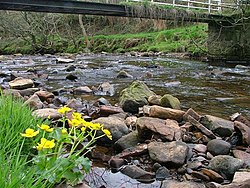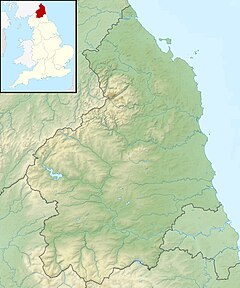47:
31:
278:
54:
178:. The Haltwhistle Burn drains an area of approximately 42 km. Today the Burn is a haven for wildlife and a popular walk for residents and tourists but from Roman times until the 1930s the combination of valuable minerals and water power attracted a succession of industries which provided goods and employment to the town.
329:
research project led by
Newcastle University. The project enabled the local community to monitor the weather and water environment using simple and low-cost methods, including rainfall, river levels and flood events. This has provided locals and scientists, who are concerned about preserving the
242:
The bed of the burn descends into the valley at a gentle angle of approximately 1 degree but the fall is sufficient to have run a corn mill and three woollen manufactories during the 18th and 19th centuries. The earliest of these processes to be mechanised was
310:, as did Haltwhistle Burn Roman fort which it served. A large curving embankment survives which was built to carry the Stanegate from near the south gate of the fort down to the river, and another stretch of embankment carries the Stanegate up through a Roman
346:
observations are being used to fill the data gaps in order to understand and manage location-specific issues. Commencing in 2013, the project was one of the first in the UK to explore and implement citizen science in this way.
218:. The water of the Haltwhistle Burn has cut through these deposits giving access to building stone, clay and coal, leading to the development of the associated industries of quarrying,
259:. The advent of steam-driven mills led to the abandonment of woollen processing along the burn. Two mills were demolished in the 1930s and the remaining
285:
The remains of
Haltwhistle Burn Roman Fort are situated on the eastern bank of Haltwhistle Burn, just north of the point where it is crossed by the
298:
46:
573:
117:
475:
518:"Demonstrating the value of community-based ('citizen science') observations for catchment modelling and characterisation"
563:
458:
Kelly; et al. (2017). Kelly, Jason M.; Scarpino, Philip; Berry, Helen; Syvitski, James; Meybeck, Michel (eds.).
399:
375:
290:
294:
391:
516:
Starkey, Eleanor; Parkin, Geoff; Birkinshaw, Stephen; Large, Andy; Quinn, Paul; Gibson, Ceri (2017).
367:
311:
568:
30:
247:, with the first records on the site dating to 1612. Later, with advances in technology, the
529:
174:
and through a dramatic sandstone gorge before descending between wooded banks to the South
8:
252:
533:
277:
481:
234:, found in association with the coal seams was also smelted on the banks of the burn.
485:
471:
395:
371:
307:
171:
163:
537:
463:
339:
542:
517:
364:
Ancient
Frontiers. Exploring the geology and landscape of the Hadrian's Wall Area
343:
326:
211:
325:
The
Haltwhistle Burn has been used as an important pilot site for an innovative
187:
88:
78:
557:
437:
335:
191:
132:
119:
330:
health of the
Haltwhsitle Burn, with increased knowledge in order to manage
499:
219:
167:
223:
155:
100:
424:
467:
317:
Just to the north of the fort are three separate Roman marching camps.
215:
194:
Period when variations in sea level resulted in successive deposits of
175:
306:
Roman road dating from AD 71, the earlier northern frontier preceding
303:
256:
231:
203:
195:
159:
414:, C.E. Adamson, 1861, published by George Nicholson, Southshields.
227:
260:
248:
244:
272:
154:
is a river which lies to the east of the
Northumbrian town of
331:
286:
199:
515:
207:
426:
ed. T.F. Bulmer 1886, pub. T. Bulmer & Co. Manchester
158:. Rising in the peaty uplands below the ridge of the
302:). In-between the fort and the Military Road is the
222:, brick, tile and pipe manufacture, coal mining and
181:
500:"Community Involvement in UK Catchment Management"
555:
435:
388:Northumbrian Rocks and Landscape; a field guide.
412:History of the Manor and Church of Haltwhistle
541:
293:here dating from the eighteenth century (
281:Earthworks of Haltwhistle Burn Roman Fort
276:
53:
556:
457:
13:
320:
186:The rocks underlying this part of
14:
585:
390:ed. Colin Scrutton, published by
182:Geology and associated industries
574:Roman auxiliary forts in England
505:. Foundation for Water Research.
255:of wool was also carried out in
52:
45:
29:
16:River in Northumberland, England
462:. University California Press.
314:on the west side of the river.
509:
492:
451:
429:
417:
405:
381:
357:
237:
111: • coordinates
61:Location within Northumberland
1:
543:10.1016/j.jhydrol.2017.03.019
350:
266:
95:Physical characteristics
392:Yorkshire Geological Society
7:
10:
590:
460:Rivers of the Anthropocene
270:
190:were laid down during the
368:British Geological Survey
109:
99:
94:
84:
74:
69:
40:
28:
23:
564:Rivers of Northumberland
170:Military Zone south of
436:Newcastle University.
282:
280:
210:, known in the UK as
522:Journal of Hydrology
366:, published by the
534:2017JHyd..548..801S
263:is now a dwelling.
166:passes through the
129: /
468:10.1525/luminos.43
438:"Haltwhistle Burn"
283:
133:54.9666°N 2.4437°W
477:978-0-520-96793-9
214:and in the US as
148:
147:
581:
548:
547:
545:
513:
507:
506:
504:
496:
490:
489:
455:
449:
448:
446:
444:
433:
427:
421:
415:
409:
403:
385:
379:
361:
340:river morphology
301:
289:, the so-called
152:Haltwhistle Burn
144:
143:
141:
140:
139:
138:54.9666; -2.4437
134:
130:
127:
126:
125:
122:
56:
55:
49:
35:Haltwhistle Burn
33:
24:Haltwhistle Burn
21:
20:
589:
588:
584:
583:
582:
580:
579:
578:
554:
553:
552:
551:
514:
510:
502:
498:
497:
493:
478:
456:
452:
442:
440:
434:
430:
422:
418:
410:
406:
386:
382:
362:
358:
353:
344:citizen science
327:citizen science
323:
321:Citizen science
297:
275:
269:
240:
212:Yoredale Series
184:
137:
135:
131:
128:
123:
120:
118:
116:
115:
112:
65:
64:
63:
62:
59:
58:
57:
36:
17:
12:
11:
5:
587:
577:
576:
571:
569:Tyne catchment
566:
550:
549:
508:
491:
476:
450:
428:
416:
404:
380:
355:
354:
352:
349:
342:issues. These
322:
319:
308:Hadrian's Wall
295:grid reference
268:
265:
239:
236:
188:Northumberland
183:
180:
172:Hadrian's Wall
146:
145:
113:
110:
107:
106:
103:
97:
96:
92:
91:
89:Northumberland
86:
82:
81:
79:United Kingdom
76:
72:
71:
67:
66:
60:
51:
50:
44:
43:
42:
41:
38:
37:
34:
26:
25:
15:
9:
6:
4:
3:
2:
586:
575:
572:
570:
567:
565:
562:
561:
559:
544:
539:
535:
531:
527:
523:
519:
512:
501:
495:
487:
483:
479:
473:
469:
465:
461:
454:
439:
432:
425:
420:
413:
408:
401:
400:1-873551-11-8
397:
393:
389:
384:
377:
376:0-85272-541-8
373:
369:
365:
360:
356:
348:
345:
341:
337:
336:water quality
333:
328:
318:
315:
313:
309:
305:
300:
296:
292:
291:Military Road
288:
279:
274:
264:
262:
258:
254:
250:
246:
235:
233:
230:production.
229:
225:
221:
217:
213:
209:
205:
201:
197:
193:
192:Carboniferous
189:
179:
177:
173:
169:
165:
161:
157:
153:
142:
114:
108:
104:
102:
98:
93:
90:
87:
83:
80:
77:
73:
68:
48:
39:
32:
27:
22:
19:
525:
521:
511:
494:
459:
453:
441:. Retrieved
431:
423:
419:
411:
407:
387:
383:
363:
359:
324:
316:
284:
261:fulling mill
241:
220:lime burning
185:
151:
149:
18:
528:: 801–817.
238:Water power
224:coke (fuel)
176:Tyne Valley
156:Haltwhistle
136: /
558:Categories
351:References
299:NY71456614
271:See also:
267:Roman fort
257:watermills
216:cyclothems
121:54°58′00″N
486:130235656
304:Stanegate
232:Ironstone
204:sandstone
196:limestone
160:Whin Sill
124:2°26′37″W
443:27 April
370:, 2006,
253:spinning
228:coal-gas
70:Location
530:Bibcode
312:cutting
249:carding
245:fulling
75:Country
484:
474:
398:
374:
334:risk,
273:Aesica
206:, and
162:, the
105:
85:County
503:(PDF)
482:S2CID
394:1995
332:flood
287:B6318
200:shale
168:Roman
101:Mouth
472:ISBN
445:2017
396:ISBN
372:ISBN
338:and
251:and
226:and
208:coal
164:burn
150:The
538:doi
526:548
464:doi
560::
536:.
524:.
520:.
480:.
470:.
202:,
198:,
546:.
540::
532::
488:.
466::
447:.
402:.
378:.
Text is available under the Creative Commons Attribution-ShareAlike License. Additional terms may apply.

